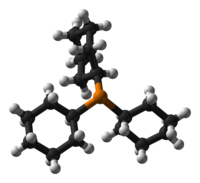Tricyclohexylphosphine
 |
|
 |
|
 |
|
| Names | |
|---|---|
|
IUPAC name
Tricyclohexylphosphane
|
|
| Other names
P(Cy)3
PCy3 |
|
| Identifiers | |
|
3D model (Jmol)
|
|
| ChemSpider | |
| ECHA InfoCard | 100.018.246 |
|
PubChem CID
|
|
|
|
|
|
| Properties | |
| C18H33P | |
| Molar mass | 280.43 g mol−1 |
| Appearance | white solid |
| Melting point | 82 °C (180 °F; 355 K) |
| organic solvents | |
| Hazards | |
| Main hazards | toxic |
|
Except where otherwise noted, data are given for materials in their standard state (at 25 °C [77 °F], 100 kPa).
|
|
|
|
|
| Infobox references | |
Tricyclohexylphosphine is the tertiary phosphine with the formula P(C6H11)3. Commonly used as a ligand in organometallic chemistry, it is often abbreviated to PCy3, where Cy stands for cyclohexyl. It is characterized by both high basicity (pKa = 9.7) and a large ligand cone angle (170°).
Important complexes containing P(Cy)3 ligands include the 2005 Nobel Prize-winning Grubbs' catalyst and the homogeneous hydrogenation catalyst Crabtree's catalyst.
Grubbs' catalyst (first generation)
Crabtree's catalyst
...
Wikipedia
